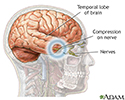Brain herniation
Herniation syndrome; Transtentorial herniation; Uncal herniation; Subfalcine herniation; Tonsillar herniation; Herniation - brain
Brain herniation is the shifting of the brain tissue from one space in the skull to another through various folds and openings.
Causes
Brain herniation occurs when something inside the skull produces pressure that moves brain tissues. This is most often the result of brain swelling or bleeding from a head injury, stroke, or brain tumor.
Brain herniation can be a side effect of tumors in the brain, including:
Herniation of the brain can also be caused by other factors that lead to increased pressure inside the skull, including:
- Collection of pus and other material in the brain, usually from a bacterial or fungal infection (abscess)
- Bleeding in the brain (hemorrhage)
- Buildup of fluid inside the skull that leads to brain swelling (hydrocephalus)
- Strokes that cause brain swelling
- Swelling after radiation therapy
- Defect in brain structure, such as a condition called Arnold-Chiari malformation
Brain herniation can occur:
- From side to side or down, under, or across rigid membrane like the tentorium or falx
- Through a natural bony opening at the base of the skull called the foramen magnum
- Through openings created during brain surgery
Symptoms
Signs and symptoms may include:
- High blood pressure
- Irregular or slow pulse
- Severe headache
- Weakness
- Cardiac arrest (no pulse)
- Loss of consciousness, coma
- Loss of all brainstem reflexes (blinking, gagging, and pupils reacting to light)
- Respiratory arrest (no breathing)
- Wide (dilated) pupils and no movement in one or both eyes
Exams and Tests
A brain and nervous system exam shows changes in alertness. Depending on the severity of the herniation and the part of the brain that is being pressed on, there will be problems with one or more brain-related reflexes and nerve functions.
Tests may include:
- X-ray of the skull and neck
- CT scan of the head
- MRI scan of the head
- Blood tests if an abscess or a bleeding disorder is suspected
Treatment
Brain herniation is a medical emergency. The goal of treatment is to save the person's life.
To help reverse or prevent a brain herniation, the medical team will treat increased swelling and pressure in the brain. Treatment may involve:
- Placing a drain into the brain to help remove cerebrospinal fluid (CSF)
- Medicines to reduce swelling, especially if there is a brain tumor
- Medicines that decrease brain swelling, such as mannitol, saline, or other diuretics
- Placing a tube in the airway (endotracheal intubation) and increasing the breathing rate to reduce the levels of carbon dioxide (CO2) in the blood
- Removing blood or blood clots if they are raising pressure inside the skull and causing herniation
- Removing part of the skull to give the brain more room
Outlook (Prognosis)
People who have a brain herniation usually have a serious brain injury. They may already have a low chance of recovery due to the injury that caused the herniation. When herniation occurs, it further lowers the chance of recovery.
The outlook varies, depending on where in the brain the herniation occurs. Without treatment, death is likely.
There can be damage to parts of the brain that control breathing and blood flow. This can rapidly lead to death or brain death.
Possible Complications
Complications may include:
- Brain death
- Permanent and significant neurologic problems
When to Contact a Medical Professional
Call 911 or the local emergency number or take the person to a hospital emergency room if they develop decreased alertness or other symptoms, especially if there has been a head injury or if the person has a brain tumor or blood vessel problem.
Prevention
Prompt treatment of increased intracranial pressure and related disorders may reduce the risk for brain herniation.
References
Beaumont A. Physiology of the cerebrospinal fluid and intracranial pressure. In: Winn HR, ed. Youmans and Winn Neurological Surgery. 8th ed. Philadelphia, PA: Elsevier; 2023:chap 69.
Papa L, Goldberg SA. Head trauma. In: Walls RM, ed. Rosen's Emergency Medicine: Concepts and Clinical Practice. 10th ed. Philadelphia, PA: Elsevier; 2023:chap 33.
Stippler M, Mahavadi A. Craniocerebral trauma. In: Jankovic J, Mazziotta JC, Pomeroy SL, Newman NJ, eds. Bradley and Daroff's Neurology in Clinical Practice. 8th ed. Philadelphia, PA: Elsevier; 2022:chap 62.
Review Date: 7/26/2022
Reviewed By: Evelyn O. Berman, MD, Assistant Professor of Neurology and Pediatrics at University of Rochester, Rochester, NY. Review provided by VeriMed Healthcare Network. Also reviewed by David C. Dugdale, MD, Medical Director, Brenda Conaway, Editorial Director, and the A.D.A.M. Editorial team.










